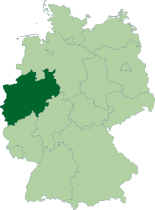Bielefeld
| Bielefeld | |
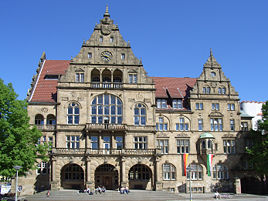 |
|
| Coat of arms | Location |
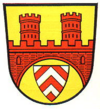 |
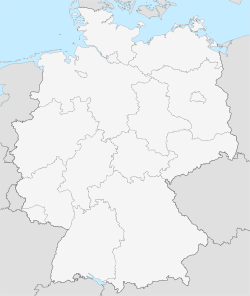 |
| Administration | |
| Country | Germany |
|---|---|
| State | North Rhine-Westphalia |
| Admin. region | Detmold |
| District | Urban district |
| City subdivisions | 10 districts |
| Mayor | Eberhard David (CDU) |
| Basic statistics | |
| Area | 257.8 km² (99.5 sq mi) |
| Elevation | 118 m (387 ft) |
| Population | 325,846 (30/12/2006) |
| - Density | 1,264 /km² (3,274 /sq mi) |
| Founded | 1214 |
| Other information | |
| Time zone | CET/CEST (UTC+1/+2) |
| Licence plate | BI |
| Postal codes | 33501-33739 |
| Area codes | 0521, 05202-05209 |
| Website | www.bielefeld.de |
| Districts of Bielefeld | |
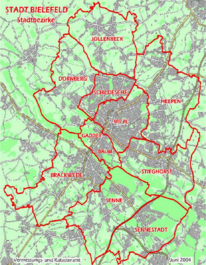 |
|
Bielefeld (IPA: [ˈbiːləfɛlt]) is a district-free town in the Regierungsbezirk Detmold in the north-east of North Rhine-Westphalia, Germany. It is located at on both the western and eastern slopes of the Teutoburg Forest. With its population of 326,000, it is the biggest city of the Ostwestfalen-Lippe Region. The current mayor is Eberhard David.
The name Bielefeld is derived from the old name bileveld, which means "hilly field". The city is situated below a pass separating the Northern and Southern Teutoburg Forest. The centre of Bielefeld is situated on the eastern side of the Teutoburg Forest, but the modern city incorporates boroughs on the opposite side and on the hilltops.
Contents |
History
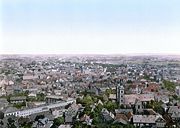
Bielefeld was founded in 1214 by Count Hermann IV of Ravensberg to guard a pass crossing the Teutoburg Forest. Bielefeld was a minor member of the Hanseatic League since the 14th century and profited greatly from its status as the "city of linen". Sparrenberg Castle was built in the medieval town around 1250 and fortified in 1550. It later decayed to the point of ruin, until the town purchased the ruins from the state and began rebuilding in 1879.
Ravensberg, including Bielefeld, was inherited by Berg in 1346. The territory then passed to the Margraviate of Brandenburg in the 1614 Treaty of Xanten. Bielefeld was administered within Minden-Ravensberg from 1719–1807, after which it was part of the Kingdom of Westphalia. Restored to the Kingdom of Prussia after the Napoleonic Wars, Bielefeld was subsequently administered within the Prussian province of Westphalia.
Bielefeld began its industrial rise in the 1850s, after the new Cologne-Minden railway created a connection to the larger German and European rail network. 1851 saw the construction of the first large mechanised spinning mill in the town by the Bozi brothers. Later years witnessed the construction of additional mills including the Ravensberg Spinning Mill, built between 1854 and 1857. In addition to these mills, metal works began to open in the 1860s.
Between 1904 and 1930, Bielefeld grew, opening a railway station, a municipal theatre, and finally, the Rudolf Oetker-Halle concert hall, famous for its excellent acoustics [1]. The 1930s, as in much of Germany, saw the dissolution and the banning of democratic political parties, and the town's synagogue was burned in 1938.
During World War II, the Bielefeld railway viaduct was the first target to be attacked with Barnes Wallis' Grand Slam bomb by 617 ("Dambusters") squadron of the R.A.F. 1944 saw heavy bombing, leaving large areas of the town in rubble. American troops entered the city in April 1945.
Industry
Major industries in Bielefeld currently include food processing, home appliance manufacture, information technology, and various heavy industries.
Bielefeld was the original home to the AG Dürkoppwerke company, which began in 1867 as a humble sewing machine repair company with only two employees [2]. The company developed its own sewing machine and expanded rapidly, moving into the production of bicycles and gas and kerosene engines. In 1892, the year of its 25th anniversary, the company employed 1,665 people. After continued growth and diversification through the early parts of the 20th century, the company switched to war production, building machine guns, grenades, and chassis for tanks. This led to the bombing and destruction of the plant at the end of 1944. At the close of the war production began again, with a focus on bicycles, motorcycles and household sewing machines. In 1990, the company merged with several other Bielefeld companies to form Dürkopp Adler AG.
The food manufacturer, Dr. Oetker, is an internationally operating corporation founded and based in Bielefeld. Other major companies traditionally based in or near Bielefeld are Möller Group (leather products and plastics) and Seidensticker (clothing and textiles).
Education
The Bielefeld University was founded in 1969. Among its first professors was the notable contemporary German sociologist Niklas Luhmann. Other institutions of higher education include the Theological Seminary Bethel (Kirchliche Hochschule Bethel) and the Fachhochschule (see Fachhochschule) which is internationally renowned for its fine education in photography and design.
Urban Districts
In 1973 the first villages on the opposite side of the Teutoburg Forest were incorporated. The current districts of the city are: Bielefeld-Mitte (downtown), Brackwede, Dornberg, Gadderbaum, Heepen, Jöllenbeck, Schildesche, Senne, Sennestadt and Stieghorst.
Traffic

Two major autobahns, the A 2 and A 33, intersect at the south east of Bielefeld. The Ostwestfalendamm expressway connects the two parts of the city naturally divided by the Teutoburg Forest. The main railroad station of Bielefeld is part of the German ICE high-speed railroad system. Bielefeld has a small airstrip in the Senne district but is mainly served by the two larger airports nearby, Paderborn-Lippstadt and Münster-Osnabrück.
Bielefeld boasts a well developed public transport system, served mainly by the companies moBiel (formerly Stadtwerke Bielefeld - Verkehrsbetriebe) and BVO. An underground with four major lines and regional trains connect different parts of the city with nearby counties. Buses also run throughout the entire vicinity.
Main sights

Sparrenburg Castle is the most famous landmark. It was built between 1240 and 1250 by Count Ludwig von Ravensberg. The 37 m (121 ft) high tower and the catacombs of the castle are open to the public.
The Old City Hall (Altes Rathaus) was built in 1904 and still serves the same function. On its facade on can find various architectural styles, including elements of the Gothic style and of the Renaissance. Though the mayor still holds office in the Old City Hall, the most of the city's administration is housed in the adjacent New City Hall (Neues Rathaus).
The City Theater (Stadttheater) is part of the same architectural ensemble as the Old City Hall, also built in 1904. It has a notable Jugendstil facade and is Bielefeld's largest theater. Another theater (Theater am Alten Markt) resides in the former town hall building on the Old Marketplace (Alter Markt), which also contains a row of restored 16th and 17th century townhouses with noteworthy late Gothic and Weser Renaissance style facades (Bürgerhäuser am Alten Markt).
The oldest city church is Altstädter Nicolaikirche. It is a Gothic hall church with a height of 81.5 m (267 ft). It was founded in 1236 by the Bishop of Paderborn, and enlarged at the beginning of the 14th century. The church was damaged in World War II and later rebuilt. Three times a day, a carillon can be heard. The most valuable treasure of this church is a carved altar from Antwerp, decorated with 250 figures. A small museum housed within illustrates the history of the church up to World War II.
The largest church is the Neustädter Marienkirche, a Gothic hall church dating back to 1293, completed 1512. It stands 78 m (256 ft) tall and has a length of 52 m (161 ft). Historically speaking, this building is considered to be the most precious. It was the starting point of the Protestant Reformation in Bielefeld in 1553. A valuable wing-altar with 13 pictures, known as the Marienaltar is also kept inside. The baroque spires were destroyed in World War II and later replaced by two unusually-shaped "Gothic" clocktowers.
Bielefeld is also the seat of the two largest Protestant social welfare establishments (Diakonie) in Europe, the von Bodelschwingsche Anstalten Bethel and the Evangelisches Johanneswerk.
Other important cultural sights of the region are the art museum (Kunsthalle) and the Rudolf Oetker concert hall (Rudolf-Oetker-Halle).
On Hünenburg there is an observation tower, next to a 164 meters (538 ft) high broadcast tower.
Trivia

- The original name of the Teutoburg Forest was Osning. During the rise of German nationalism around 1848/1849, people became aware of the reference in Tacitus's Annals I 60, which refers to a defeat of the Roman army at saltus Teutoburgiensis. The similarity resulted in the renaming for "patriotic" reasons, while the actual site is now believed to have been about 40 km (25 miles) north, near Osnabrück. The details of what is known as the Varus Battle are currently subject to archaeological debates.
- The altarpiece of the Bielefeld church Neustädter Marienkirche from around 1400 is among the most prominent masterpieces of artwork of the German Middle Ages. Two of the altarpieces, The Flagellation and The Crucifixion are now in the collection of the Metropolitan Museum of Art in New York.
- Being a strategically highly important point of the traffic connection between Ruhrgebiet and Berlin, the first ten tonne Grand Slam bomb, the largest conventional bomb of World War II, was dropped by the No. 617 Squadron of the British Royal Air Force on the railroad viaduct of Bielefeld shortly before Germany surrendered. The viaduct has been rebuilt with a different design.
- Among German netizens, especially on the Usenet, a running gag is the claim that Bielefeld does not exist. This is known as the "Bielefeld Conspiracy".
- In 1923, during the inflation in the Weimar Republic, Bielefeld, along with several thousand other German towns, issued Notgeld (emergency money). Due to inflation, this money was hardly worth the paper it was printed on, but it became popular with collectors, and towns vied to print and sell as much currency on the collector market as possible through attractive designs. Bielefeld raised the bar and became one of the most popular (and collectable) issuers by printing banknotes on silk, leather, linen, wood, velvet and other materials.
Twinning
Bielefeld's twin towns are:
 Concarneau, France
Concarneau, France Enniskillen, United Kingdom
Enniskillen, United Kingdom Rochdale, United Kingdom
Rochdale, United Kingdom Rzeszów, Poland
Rzeszów, Poland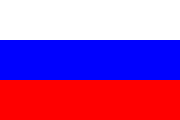 Veliky Novgorod, Russia
Veliky Novgorod, Russia Nahariya, Israel
Nahariya, Israel
References
External links
- Official Bielefeld homepage
- Live webcam of the central plaza Jahnplatz of Bielefeld
- Deutsche Welle - Conspiracy Theory: Bielefeld does not exist
- Photos
|
||||||||||
